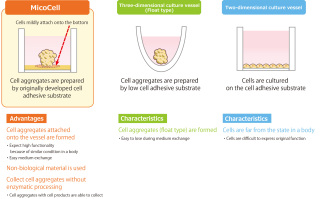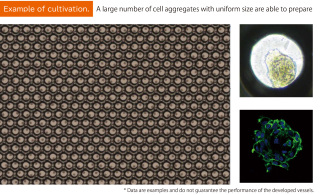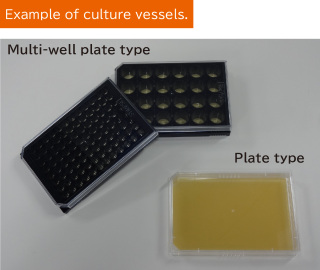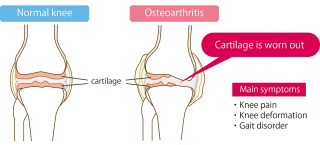Nippon Shokubai Starts Providing Its 3D Cell Culture Vessel MicoCellTM for Knee Osteoarthritis Clinical Research
Nippon Shokubai Co., Ltd. (Head Office: Osaka, Japan President: Yujiro Goto, hereinafter “Nippon Shokubai”) developed a 3D cell culture vessel “MicoCell” and will provide for clinical research on adipose-derived stem cell aggregates to the medical corporation, Saiseikai Sobajima Clinic (Location: Osaka, Japan, Director: Satoshi Sobajima, hereinafter “Sobajima Clinic”).
MicoCel is a three-dimensional cell culture vessel developed by Nippon Shokubai with our unique technology. MicoCell has a characteristic to produce large quantities of cell aggregates whose properties are similar to the state of those in a living body with a uniform particle size. This clinical research targets for the treatment of an osteoarthritis using patients’ own adipose-derived stem cells. Sobajima Clinic submitted a “Type 2 regenerative medicine plan” required by “Act on the Safety of Regenerative Medicine” to Regenerative Medicine Committee and approved on June 10, 2020.
MicoCell is made of non-biological material with mildly attached cell aggregates on the surface of culture vessels, and is characterized by the ability to form a large number of mildly attached cell with uniform particle size. Unlike conventional cells cultured in two dimensions, cell aggregates are known to produce cells whose properties are similar to the state of those in a living body, and thus techniques for preparing cell aggregates have attracted global attention in recent years.
Currently, commercially available culture vessels for the formation of cell aggregates are generally prepared by treating the inside of the vessel with low cell adhesive substrates, resulting cell aggregates not to interact with the substrate (floating state). On the other hand, in the case of MicoCell, Since cell aggregates are formed on the surface of the culture vessel and they mildly attached onto the bottom, these cell aggregates are expected to have further enhanced functions and have a great therapeutic effect which are not shown by floating cell aggregates formed in other culture vessels (Figure 1). In addition, before starting the clinical research, we have confirmed non-clinically that MicoCell’s cell aggregates have great potency and safety compared with cells cultured in two dimensions and floating cell aggregates prepared by other three-dimensional culture vessels.
Moreover, MicoCell has three other characteristics. (1) Medium exchange during cultivation is easy and also easy to handle. (2) A large number of homogeneously sized cell aggregates are prepared by micro-cavity structures in the vessel. (3) After the formation of cell aggregates, they can be detached and collected from the vessel without enzymatic processing. These features enable efficient production of cell aggregates (Figure 2 and 3).
Knee osteoarthritis (OA), the target of this clinical research, is a symptom in which cartilage in the knee is worn out or lost, deforming the knee, and resulting in pain and swelling (Figure 4). Approximately 10 million patients are reported to be in Japan, which include approximately over 33 million potential patients with no subjective symptoms but whose symptoms are confirmed by X-ray diagnosis. The major cause of the disease is aging, and the number of patients has been increasing as the aging of population advances.※
For the treatment of such patients, dosing of painkillers or intra-articular injection of hyaluronan has been selected, while a joint replacement has been conducted for seriously injured patients. This replacement requires highly invasive surgery and therefore the treatment with low invasive and without hospitalization has been eagerly required.
In the clinical research by Sobajima Clinic, adipose-derived stem cells obtained by culturing a small amount of the patient’s own fat are prepared to cell aggregates by MicoCell and injected to OA part (Figure 5). This makes it possible to perform a minimal one-day treatment without having to be hospitalized for both fat collection and injection.
In this clinical research, we believe that the safety of cell aggregates prepared by MicoCell will be demonstrated by injecting them, and believe it would make a significant contribution to the practical application of cell aggregate-based treatment and further development of regenerative medicine.
Terminology Description
・Regenerative medicine
Medical treatment that uses cells or artificial materials to regenerate the lost functions of an organ or tissue whose original functions are lost due to injury or disease.
・Stem cell
A cell that has both the ability to self-replication and the ability to differentiate into various types of cells. Adipose-derived stem cells, which are also present in the body, are particularly promising for use in regenerative medicine because of their ease of collection, proliferation, and differentiation.
・Cell aggregate (spheroid)
A three-dimensional aggregation of cells. It is also called “spheroid”. Compared with conventional two-dimensional cells, it has become clear that cells behave in a similar manner to the state in the body, and applications in regenerative medicine and drug discovery are expected.
・Knee osteoarthritis
A disease that cartilage of the knee is worn out or lost and the shape of the knee is deformed, results in pain and swelling. It sometimes abbreviates as “OA”.
・Clinical research
The term “clinical research” refers to medical research conducted for the purpose of improving methods for preventing, diagnosing, and treating diseases, understanding the causes and conditions of diseases, and improving the quality of life of patients in medical care. In the case of regenerative medicine, procedures are conducted in accordance with Act on the Safety of Regenerative Medicine.
※Survey by the Japanese Ministry of Health, Labor and Welfare, Health and Welfare Bureau for the Elderly
About NIPPON SHOKUBAI Co., Ltd.: Since 1941, Nippon Shokubai has grown up its business with unique catalyst technology. Nippon Shokubai has supplied, for example, ethylene oxide, acrylic acid, automobile catalysts, process catalysts and so on. Among all, our global market share of superabsorbent polymer is the largest in the world now. Nippon Shokubai is a global chemical company operating under its corporate mission “TechnoAmenity-Providing affluence and comfort to people and society with our unique technology.” http://www.shokubai.co.jp/en/
【Contacts】
Investor & Public Relations Dept.,
NIPPON SHOKUBAI CO., LTD.
TEL: +81-3-3506-7605 E-mail: shokubai@n.shokubai.co.jp





[Files]